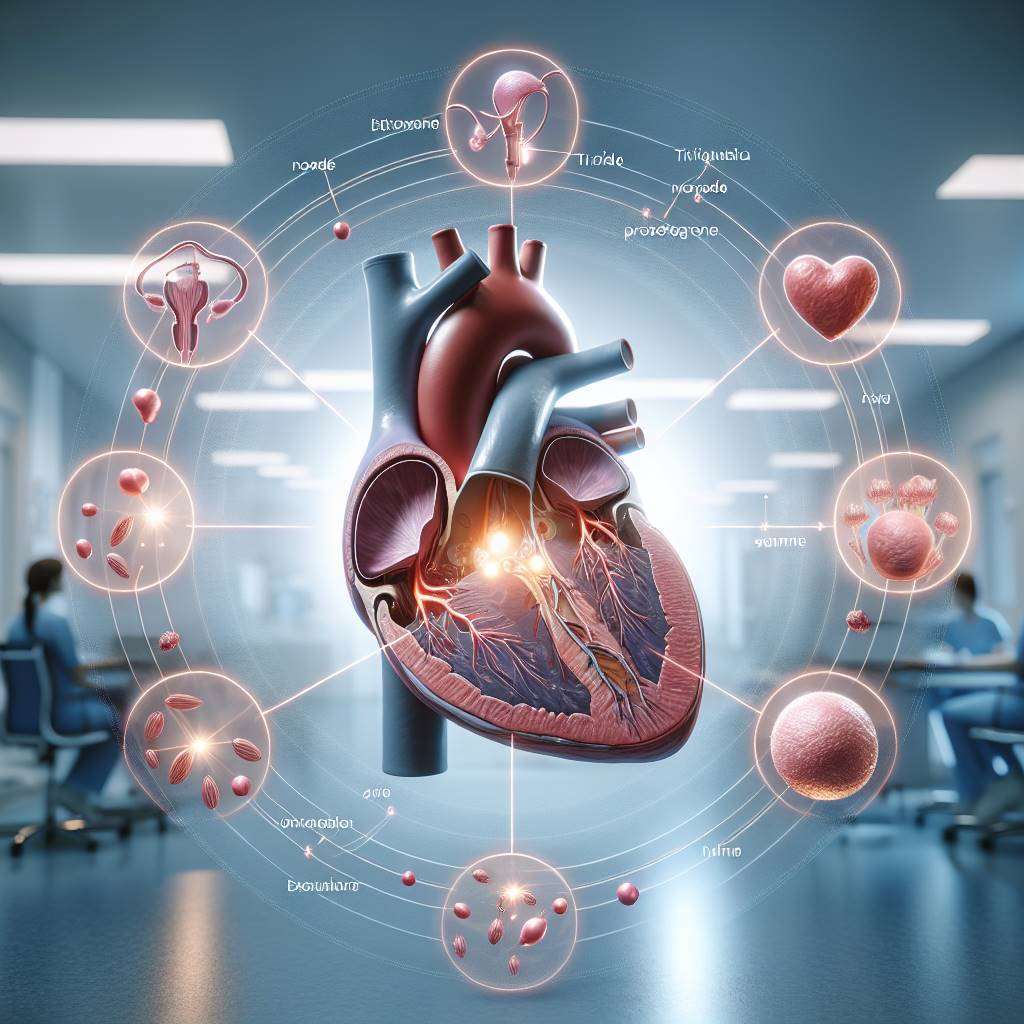Research on gender differences in pacemaker outcomes has revealed significant variations in how men and women respond to this life-saving device. Pacemakers are critical for managing arrhythmias, but their effectiveness and potential complications may differ based on biological and hormonal factors. Understanding these differences is essential for improving patient care and outcomes.
Studies suggest that women may experience different pacemaker complications and benefits compared to men. These differences highlight the need for gender-specific research and treatment strategies. By addressing these disparities, healthcare providers can ensure better cardiac care and improve the quality of life for all pacemaker patients.
Do Men and Women Respond Differently to Pacemakers?
Men and women often exhibit distinct responses to pacemaker implantation, influenced by anatomical and physiological differences. For example, women generally have smaller heart sizes, which can affect the placement and functionality of the device. Hormonal variations may also play a role in how the heart interacts with the pacemaker.
Research indicates that women may experience higher sensitivity to electrical impulses from pacemakers, potentially leading to better outcomes in some cases. However, they are also more likely to report discomfort or complications such as lead dislodgement or infection. These differences underscore the importance of tailoring pacemaker settings and follow-up care based on gender.

Understanding Gender-Specific Outcomes in Pacemaker Patients
Gender-specific outcomes in pacemaker patients are influenced by a variety of factors, including body composition, hormonal levels, and underlying cardiac conditions. Women are more likely to experience certain complications, such as hematomas or lead-related issues, due to their smaller vein sizes and different tissue characteristics.
On the other hand, men may have a higher risk of developing long-term issues like device erosion or mechanical failure. These differences highlight the need for personalized approaches in pacemaker management. Physicians must consider gender when selecting device types, programming settings, and planning follow-up care to optimize outcomes for both men and women.
How Gender Impacts Pacemaker Effectiveness and Longevity
The effectiveness and longevity of pacemakers can vary significantly between genders. Women often benefit from lower pacing thresholds, which means their devices may last longer due to reduced battery usage. However, they are also more prone to complications like pocket infections or skin erosion, which can impact device longevity.
Men, on the other hand, may require higher pacing thresholds due to larger heart sizes and different electrical conduction patterns. This can lead to faster battery depletion and the need for more frequent replacements. A better understanding of these gender-specific factors can help improve device design and enhance the overall quality of care for pacemaker patients.
Key Research Findings on Pacemakers and Gender Differences
Recent studies have shed light on the gender disparities in pacemaker outcomes. For instance, women are more likely to experience improved survival rates and better symptom relief after pacemaker implantation compared to men. However, they also face a higher risk of procedural complications, such as vascular injury or lead displacement.
A comparative analysis of outcomes is summarized in the table below:
| Aspect |
Women |
Men |
| Survival Rates |
Higher |
Moderate |
| Complication Risk |
Higher |
Lower |
| Battery Longevity |
Longer |
Shorter |
These findings emphasize the importance of gender-specific research to improve outcomes and minimize risks for all pacemaker patients.
Are Women at Higher Risk of Pacemaker Complications?
Women are indeed at a higher risk of certain pacemaker-related complications. Studies have shown that they are more likely to develop issues such as lead dislodgement, pocket hematomas, and infections. These risks are partly due to anatomical differences, including smaller vein sizes and thinner tissue layers.
Despite these challenges, women often report better symptom relief and improved quality of life after pacemaker implantation. To reduce complications, healthcare providers should adopt a gender-sensitive approach, including careful device selection and meticulous surgical techniques. Regular follow-ups and patient education can also play a crucial role in minimizing risks and ensuring optimal outcomes.
Gender-Based Variations in Pacemaker Implantation Success Rates
Research has shown that there are notable gender-based differences in the success rates of pacemaker implantation. Women and men often experience varying outcomes due to differences in anatomy, hormonal influences, and the progression of underlying heart conditions. For example, women may have smaller heart structures, which can influence the placement and functioning of the pacemaker device.
Studies also suggest that women are more likely to experience complications such as lead dislodgement or infection post-implantation. However, they may also benefit from improved symptom relief compared to men. These differences highlight the importance of tailoring pacemaker therapy to individual needs, taking into account gender-specific factors.

Why Pacemaker Outcomes Differ Between Men and Women
The differences in pacemaker outcomes between men and women can be attributed to several factors. Women often present with different symptoms of heart conditions, which may delay diagnosis and treatment. Additionally, hormonal influences, such as the protective effects of estrogen, can impact the progression of heart diseases and the response to pacemaker therapy.
Another factor is the variation in device programming. Women may require different pacemaker settings to optimize their heart rhythm due to differences in heart rate variability. Furthermore, the smaller size of women’s blood vessels and heart chambers can make implantation more technically challenging, increasing the risk of complications.
- Delayed diagnosis due to atypical symptoms in women
- Hormonal influences affecting heart disease progression
- Technical challenges during implantation
Exploring Gender Bias in Pacemaker Clinical Trials
Gender bias in clinical trials has been a longstanding issue in medical research, including studies on pacemakers. Historically, men have been overrepresented in cardiovascular research, leading to a lack of gender-specific data. This imbalance can result in pacemaker devices and therapies being optimized for male physiology, potentially reducing their effectiveness for women.
Recent efforts have aimed to include more women in clinical trials to better understand how gender impacts pacemaker outcomes. However, challenges remain, such as addressing the underreporting of adverse events in women and ensuring that trial designs account for gender-specific factors. Bridging this gap is essential for improving outcomes for all patients.
Do Women Experience Better Quality of Life with Pacemakers?
Studies suggest that women may experience a greater improvement in quality of life after pacemaker implantation compared to men. This could be due to the fact that women often report more severe symptoms before receiving a pacemaker, making the relief provided by the device more noticeable.
However, women are also more likely to experience certain complications, such as device-related infections or discomfort at the implantation site. Despite these challenges, many women report significant improvements in energy levels, reduced symptoms of arrhythmias, and better overall well-being after receiving a pacemaker.
| Aspect |
Men |
Women |
| Symptom Relief |
Moderate |
Significant |
| Complication Risk |
Lower |
Higher |
| Quality of Life Improvement |
Good |
Excellent |
Gender-Specific Challenges in Pacemaker Therapy Management
Managing pacemaker therapy presents unique challenges for men and women. Women are more likely to experience skin irritation or discomfort due to the smaller size of their chest cavity, which can make the device more noticeable. Additionally, hormonal fluctuations can impact the functioning of the pacemaker, requiring frequent adjustments.
For men, challenges often include a higher likelihood of developing scar tissue around the implantation site, which can interfere with the device’s performance. Both genders may face psychological challenges, such as anxiety about living with a medical device. Addressing these issues requires a personalized approach to therapy management, including regular follow-ups and patient education.
Hormonal Influence on Pacemaker Performance in Women
Research indicates that hormonal fluctuations in women can significantly impact the performance of a pacemaker. Hormones like estrogen and progesterone influence the electrical activity of the heart, potentially altering how a pacemaker functions over time.
For instance, during pregnancy or menopause, hormonal changes may lead to variations in heart rate or rhythm, requiring adjustments to pacemaker settings. Women with conditions like arrhythmias may experience unique challenges due to these hormonal effects. Understanding these interactions is crucial for optimizing treatment outcomes.
Doctors often recommend regular follow-ups to monitor pacemaker performance in women, especially during periods of hormonal change. This ensures that the device continues to meet the patient’s needs effectively.

Pacemaker-Related Mortality Rates: A Gender Comparison
Studies have shown that mortality rates associated with pacemakers can differ between men and women. Women often experience better survival rates post-implantation, possibly due to differences in heart structure and response to treatment.
However, women are also more likely to face complications such as device-related infections or lead dislodgement. These issues highlight the importance of gender-specific research to improve outcomes for all patients. Men, on the other hand, may benefit from larger device sizes due to anatomical differences.
To address these disparities, healthcare providers must consider gender when planning pacemaker implantation and follow-up care. This approach ensures that both men and women receive tailored, effective treatment.
How Body Size and Gender Affect Pacemaker Placement
Body size and gender play a significant role in the placement of pacemakers. Women, who generally have smaller body frames, may face challenges such as discomfort or visible device bulges after implantation. Men, with larger chest cavities, often experience fewer such issues.
Proper placement is crucial to avoid complications like lead dislodgement or pocket infections. Surgeons must carefully assess the patient’s anatomy to determine the best implantation site. For women, submammary placement may be considered to improve comfort and aesthetics.
| Factor |
Impact on Pacemaker Placement |
| Body Size |
Smaller frames may lead to visible bulges or discomfort. |
| Gender |
Women may require alternative placement techniques for better outcomes. |
Addressing Gender Disparities in Pacemaker Research and Care
Gender disparities in pacemaker research and care remain a significant concern. Historically, clinical trials have included fewer women, leading to a lack of data on how pacemakers perform in female patients.
To bridge this gap, researchers are now focusing on gender-specific studies to understand differences in outcomes, complications, and device performance. Healthcare providers are also being trained to recognize and address these disparities in their practice.
Patients can advocate for themselves by asking about gender-specific risks and benefits during consultations. This proactive approach ensures that both men and women receive equitable, high-quality care tailored to their unique needs.
What Women Should Know About Pacemaker Outcomes
Women considering a pacemaker should be aware of several key factors. First, they may experience better survival rates but are also at higher risk for certain complications, such as infections or lead issues. Regular follow-ups are essential to monitor device performance.
Second, hormonal changes can impact how the pacemaker functions, making it important to communicate any changes in health or symptoms to your doctor. Women should also discuss placement options to ensure comfort and minimize visible scarring.
- Understand the risks and benefits of pacemaker implantation.
- Schedule regular check-ups to ensure optimal device performance.
- Discuss placement options with your doctor for better comfort.
By staying informed and proactive, women can achieve better outcomes and improve their quality of life with a pacemaker.
Best Pacemaker Surgery Doctors in India
Dr. Balbir Singh, affiliated with Medanta - The Medicity, Gurugram, is a renowned cardiologist with over 30 years of experience. He specializes in electrophysiology and pacemaker implantation. Another expert is Dr. T. S. Kler from Fortis Escorts Heart Institute, Delhi, with DM in Cardiology and 40 years of experience. Both are internationally recognized for their expertise in advanced cardiac care.
Learn more on best pacemaker implantation surgery doctors in india
Best Pacemaker Surgery Hospitals in India
Fortis Escorts Heart Institute, Delhi, and Medanta - The Medicity, Gurugram, are leading hospitals for pacemaker implantation. Both are NABH and JCI accredited, offering cutting-edge technologies like robotic-assisted cardiac procedures. These hospitals provide comprehensive care, international patient services, and have a track record of successful outcomes in complex cases.
Find more best pacemaker implantation surgery hospitals in india
Pacemaker Surgery Cost in India
The cost of pacemaker implantation in India typically ranges from INR 2,50,000 to INR 5,00,000 (approximately USD 3,000 to USD 6,000). Factors such as the type of pacemaker, hospital category, and doctor’s expertise influence the cost. The average hospital stay is 2-3 days. India offers a significant cost advantage compared to Western countries, with options for medical insurance and third-party financing.
Learn pacemaker implantation surgery cost in india
Pacemaker Surgery Treatment in India
Pacemaker implantation in India involves the insertion of a small device under the skin to regulate heart rhythms. The procedure is performed using minimally invasive techniques, ensuring faster recovery. Advanced technologies like 3D mapping and robotic assistance are used in leading hospitals. Recovery typically takes 1-2 weeks, with India adhering to global medical protocols for safety and efficacy.
Learn on Pacemaker Surgery Treatment in India
FAQs
What is a pacemaker, and why is it needed?
A pacemaker is a small medical device implanted under the skin to regulate abnormal heart rhythms, such as bradycardia or arrhythmias. It ensures the heart beats at a normal rate and rhythm, improving blood flow and overall health.
How long does a pacemaker last?
The average lifespan of a pacemaker battery is 5-15 years, depending on the type and usage. Regular follow-ups with a cardiologist are essential to monitor its performance and schedule replacements when needed.
Is pacemaker implantation a safe procedure?
Yes, pacemaker implantation is a safe and routine procedure performed worldwide. In India, experienced cardiologists and advanced technologies ensure high success rates and minimal complications.
What are the types of pacemakers available?
There are three main types of pacemakers: single-chamber, dual-chamber, and biventricular pacemakers. The choice depends on the patient’s specific heart condition and medical requirements.
Can I lead a normal life with a pacemaker?
Yes, most patients with pacemakers can lead a normal and active life. However, certain precautions, such as avoiding strong magnetic fields and regular medical check-ups, are necessary.
What precautions should I take after pacemaker implantation?
Avoid heavy lifting, strenuous activities, and exposure to electromagnetic interference for a few weeks post-surgery. Follow your doctor’s advice for a smooth recovery.
Are there any risks associated with pacemaker implantation?
While rare, potential risks include infection, bleeding, or device malfunction. Choosing an experienced cardiologist and a reputed hospital minimizes these risks.
How soon can I resume normal activities after the procedure?
Most patients can resume light activities within 1-2 weeks. However, strenuous activities and heavy lifting should be avoided for at least 4-6 weeks.
Is pacemaker implantation covered by insurance in India?
Yes, most health insurance plans in India cover pacemaker implantation. It is advisable to check with your insurer for specific coverage details and reimbursement policies.
Can international patients access pacemaker treatment in India?
Yes, India is a popular destination for medical tourism. Leading hospitals offer comprehensive services, including visa assistance, accommodation, and post-treatment care for international patients.
Understanding Pacemakers: Who Needs Them and What to Expect
Pacemakers are vital medical devices that help regulate heartbeats, particularly for individuals with certain heart conditions. Understanding who needs a pacemaker is essential for those experiencing symptoms like fatigue or irregular heart rhythms. For a detailed overview of the conditions and age groups that may require this device, check out our blog on who needs a pacemaker.
The process of getting a pacemaker can be daunting, but knowing what to expect can ease anxiety. Our step-by-step guide on pacemaker implantation provides insights into the procedure, recovery, and aftercare, ensuring patients feel informed and prepared.
In conclusion, whether you or a loved one may need a pacemaker, understanding both the necessity and the implantation process can significantly enhance your experience and outcomes. Stay informed and proactive about heart health!